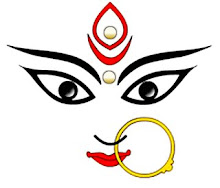 |
| Samayapuram Sree Mariamman Temple-Trichy |
About the Temple:
Samayapuram Mariamman Temple is a Hindu temple in Samayapuram near Trichy in Tamil Nadu, India. The main deity, Samayapurathal or Mariamman is made of sand and clay like many of the traditional Mariamman deities, and hence unlike many other Hindu deities there are no abhishekams [sacred washing] conducted to the main deity, but instead to the small stone statue in front of it. It is believed by the devotees that the Goddess has enormous powers over curing illnesses and hence, it is a ritual to buy small metallic replicas, made with silver or steel, of various body parts that need to be cured, and these are deposited in the donation box. Devotees also offer mavilakku, [Tamil – மாவிளக்கு] a sweet dish made of jaggery, rice flour and ghee.The temple attracts hundreds of devotees on Sundays, Tuesdays and Fridays, the holy days for Mariamman. Offerings of raw salt is also made to the Goddess by the rural devotees.Also samayapuram is the second most wealthy(in terms of cash flows) temple in tamilnadu after palani.
History
The Maariamman Temple at Samayapuram in the vicinity of Tiruchirappalli (see below), is one of the well visited shrines in Tamilnadu, dedicated to Maariamman, a manifestation of the primeval energy Shakti as the mother Goddess. Local variations of the worship of Shakti, the mother Goddess are seen throughout the Indian subcontinent. Mariamman is a form of Shakti worshipped in Tamilnadu, and is associated with prosperity and health. Local beliefs associate this deity with cures for diseases such as small pox and chicken pox.
 |
| Samayapuram Sree Mariamman |
Legend has it that Shiva created Kali, out of the poison that he had swallowed, and decreed that he kill Daarukaasuran. Having originated from the Kaalakoota poison, she assumed the name Kaali. Mariamman is believed to be a form of Kaali, and is also known as Mahamaayi or Seethala Gowri. Samayapuram was a local capital of the Vijayanagar rulers in the vicinity of Tiruchirappalli, and was known as Vikramapuram. This temple has separate shrines for the processional image of Mariamman and the moolavar in the sanctum. There is also a shrine to Karuppannasaami a local deity
History of the temple is unclear. In early 18th century, King Vijayaraya Chakkaravarthi built the present day form of the temple.There is scant history of the period before that though it is believed that the locals worship the Goddess for many centuries before building the current temple. One legend says that the present deity was at the Ranganathaswamy temple at Srirangam, and one of chief priests of the temple believed that the idol caused him illness and hence asked it to be removed from the temple. It is a common belief in that part of the region that such local Gods have immense powers and they must always be satisfied by proper offerings and sacrifices. The idol was moved outside Srirangam, and later found by some of the passerby who built a temple named, the Kannanur Mariamman temple.
During that period [around 17th century CE], Trichy was ruled by the Vijayanagar kings and the area was used as an army base. It is believed that they made a commitment to build the temple if they win the war and after attaining success they built a shrine for the Goddess. Originally it was under the management of the Thiruvanaikaval temple, a popular one in the region. Later, the control was split and currently Samayapuram is under an independent trust monitored by the Government of Tamil Nadu, which also monitors the annadanam distribution [an act of offering food to the devotees].
Festivals
- Thai Poosam, usually occurring in the Tamil month of Thai.Like most Tamil temples the main festival is during the start of the summer, generally in April. During this time, the temple chariot processions and theppams take place.
- All the Fridays in the Tamil months of Aadi [July 15 – Aug17] and Thai [Jan 15 – Feb 15] are celebrated in a grand manner.
 |
| View of the Temple Entrance |
Significance of the temple
Samayapuram is a significant symbol of the native culture in rural Tamil Nadu and there a number of unique practices concerning the Mariamman temples. Samayapuram has been used a model to describe rural folklore in a number of research works on sociology and religion.
During festivals, it is not unusual to find people doing extreme things to make their bodies suffer as an act of sacrifice including, walking over a red-hot bed of charcoal and holding hot mud-vessel in bare hands.
Heritage of Samayapuram outside India
The legacy of Samayapuram is well spread beyond Tamil Nadu and even after centuries of emigrating from India, many people in Sri Lanka, Singapore, South Africa and Fiji still maintain their loyalties to the temple and try to create similar temples and environment in their new country, raising both a cause of concern and an appreciation of diversity.






















No comments:
Post a Comment